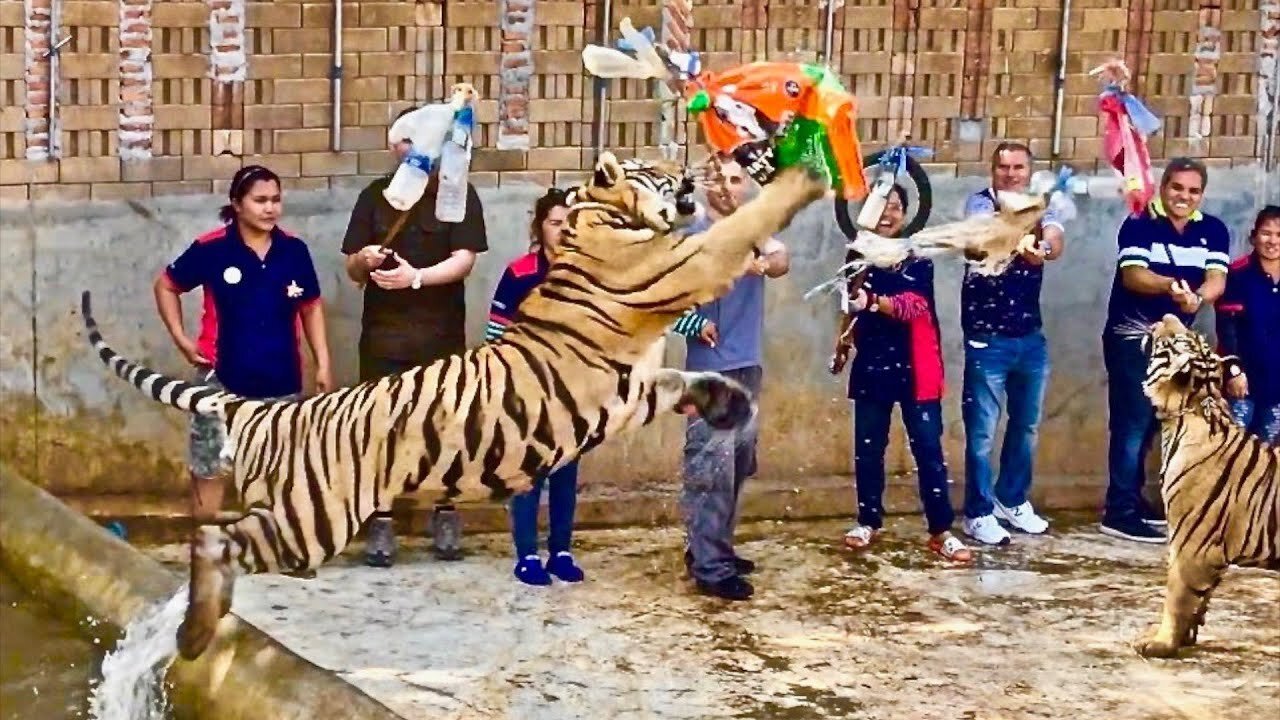Premium Only Content

Playing with Tigers in Thailand ~ The Tiger Temple ~ 4K HD
The Tiger Temple was a Theravada Buddhist temple in Thailand's Kanchanaburi Province in the west of the country. It was founded in 1994 as a forest temple and sanctuary for wild animals, among them tigers, mostly Indochinese tigers. Along with nearly 250,000 people, Jay Z, Beyoncé and their daughter Blue Ivy posed with the animals last year, and marvelled that some of the world’s fiercest creatures could be so tame. Now the doors of the temple have been closed and the animals removed. After a decade of allegations by animal groups of cruelty, illegal wildlife trafficking and breeding, 1,000 police, military and government officials descended on the temple to expose a shadowy trade in tiger parts that feeds an insatiable market in China and threatens the few remaining tigers in the wild.
Today’s population of wild tigers is estimated to be around 3,200, down from 100,000 in 1900. But research by the Environmental Investigation Agency (EIA), Australia’s Conservation and Environmental Education 4 Life (Cee4life) and others, backed by investigations for Traffic, the wildlife trade monitoring network, suggest that more than 5,000 tigers are being farmed in China, 1,450 in Thailand, 180 in Vietnam and possibly 400 in Laos. In addition, there are private collections and zoos in most other Asian countries.
Debbie Banks of the EIA has worked undercover at tiger farms in China. She says that for the past decade, tiger breeding has been a fast-expanding and lucrative industry, often masquerading as conservation. The existence of the farms is stoking demand for luxury products and traditional Chinese medicines, and endangering the few tigers left in the wild. “These places are stockpiling dead parts in freezers. This [raid in Thailand] was just the tip of a trade that spans south-east Asia and sees so-called tiger sanctuaries and farms secretly selling tiger parts and products on the black market for enormous profit,” she said.
In Kanchanaburi, what was found out of sight of the tourists shocked even hardened wildlife investigators. Apart from 137 live tigers, they found a laboratory, suggesting that the monks were using tiger parts to make wines and medicines – as well as the carcasses of 40 cubs stored in a freezer. Farms such as these – which have grown in number and size in response to rising demand for tiger bone and other body parts, and the precipitous decline in wild tigers – say they are making people aware of the tigers’ plight and claim that their captive-bred animals could be returned to the wild.
Caretakers of the 137 tigers removed from the Tiger Temple fear they will face a worse fate in government hands.
On the morning of Monday, May 30 Tanya Erzinclioglu paced around the periphery of the temple with her colleagues. Every now and again, she anxiously glanced at her phone, taking calls or checking for updates.
"I have no idea what's happening," she said repeatedly to herself.
Tanya's mornings typically involved being inside the temple grounds where she helped to feed and observe some 137 tigers who were under her partial care. It had been her routine for six years and, from the passion with which she speaks about it, it seems to be where her heart lies.
But this morning, more than 500 officers, wildlife officials, vets and police were waiting patiently outside the main entrance to the place better known as Thailand's "Tiger Temple". By the main road, a few officers sheltered from the heat under a nine-metre-high yawning tiger head sculpture.
All 137 tigers were taken in an unprecedented raid, which also unearthed dead tiger cubs, a dead bear and various animal horns.
"We knew that the temple was using the tigers for money," the DNP Deputy District General said, "By law, they cannot do that."
Tanya, however, insisted that at least some of that money had gone into improving the living conditions of the tigers - an issue paramount to her and many of her colleagues. In particular, she highlighted the temple's pride and joy: its almost five-hectare "Tiger Island" enclosure.
Completed in 2011 at an estimated cost of 90 million baht, (slightly more than $2.5m) the 28 enclosures in Tiger Island meant that, for the first time, the tigers were able to experience outside spaces, albeit on a rotating schedule.
The open areas are strikingly different from other tiger zoos in the country. At the frenetic Sriracha Zoo, activities include tiger shows that seem to, in part, include having the cats jump through flaming hoops.
When the ex-DNP director general visited the Tiger Temple in 2012, he actually praised the tiger's living conditions, telling the Bangkok Post: "Frankly speaking, their living conditions are better than those in state-owned zoos."
Music: What Must Be (Old Timey Mix) by Dhruva Aliman
Amazon- https://amzn.to/3eAjEgC
https://music.apple.com/us/artist/dhruva-aliman/363563637
https://dhruvaaliman.bandcamp.com/album/what-must-be
http://www.dhruvaaliman.com/
Spotify - https://open.spotify.com/artist/5XiFCr9iBKE6Cupltgnlet
-
 3:28
3:28
Seeker Land
9 days agoHamas Shoots Gaza Civilians Collecting US Aid - Palestinians Thank Trump & Praise Bibi Netanyahu
94 -
 2:36:40
2:36:40
DDayCobra
5 hours ago $9.19 earnedIsrael vs Iran Getting WORSE
38.9K20 -
 2:36:03
2:36:03
GamerGril
2 hours agoT.G.I. FrightDay The 13th | Who Puts The Whore In Horde
13.1K -
 LIVE
LIVE
JimmmyChaCha
3 hours agoLIVE - HALO 2 CAMPAIGN
389 watching -
 2:28:22
2:28:22
TheSaltyCracker
6 hours agoWelcome to WW3 ReeEEeeStream 06-13-25
109K239 -
 14:59
14:59
T-SPLY
8 hours agoKilmar Is Facing Trafficking Charges / Lawyer Demands His Release!
29.3K18 -
 2:04:42
2:04:42
TimcastIRL
6 hours agoU.S. Enters Israel Iran War In Defense Of Israel, Deaths CONFIRMED After Iran Strikes | Timcast IRL
179K350 -
 1:25:04
1:25:04
Laura Loomer
6 hours agoEP126: OPEN BORDERS INTIFADA
57.8K17 -
 LIVE
LIVE
Spartan
12 hours agoPro Halo Player | Scrims vs FaZe @ 3 EST then Ranked and/or SWTOR
156 watching -
 1:39:47
1:39:47
AlaskanBallistics
10 hours ago $1.07 earnedI Love this Gun Podast #44 Best 10mm Bear Protection Rounds!
17.6K1